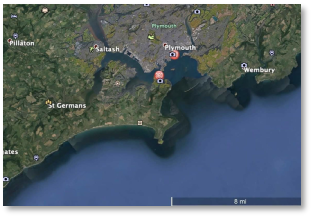



GROUP
Plymouth Field Course 2019
4
Disclaimer: the views and opinions on this website are not necessarily expressed by The National Oceanography Centre or the University of Southampton. They are completely representative of the authors of this website.
HOME
This website presents the key findings collated by Group 4 during the Plymouth field course undertaken in conjunction with the University of Southampton over the course of 10 days from the 2nd to the 12th of July 2019. Primary data was collected using a number of key sampling techniques, with samples being processed in the lab in preparation for data interpretation and analysis.
The interactive map of Plymouth below shows our areas of data collection from the inshore data collection on rib boats (Porky Pig and Flying Pig), through to the mouth of the Tamar (RV Falcon Spirit) and offshore of Plymouth (RV Callista).
Group 4 is composed of both Marine Biology and Oceanography third year undergraduates, resulting in a broad range of marine knowledge across the group. This has allowed us to fully explore the diverse interactions that take place between biological, physical and chemical processes within Plymouth waters.
Members include: Jan Ervin Carungcong, Claire Conning, Will Fitton, Baoxuan Gu, Cameron Jackson-Rowe, Emily Manning, Daniel Palmer, Giulia Rüegg, Marisa Sweeney and Josh Wilson
Introduction :
:
Location:
Plymouth Sound and the Tamar estuary are bodies of water located in the South West of the UK, bordering Cornwall and Devon. The area is a Special area of Specific Scientific Interest (SSSI) and has been since the 90’s [4].
The Tamar estuary is a particularly good research area as it is made up of three conjoining rivers; the Tamar, the Lynhen and the Tavy which feed into the mesotidal/macrotidal, partially mixed estuary[5]. As well as a highly variable salinity gradient, the estuary has a spatially and temporally varying thermocline throughout the year, often with strong stratification in the early summer months resulting in limited vertical mixing and subsequent effects on the chemical and biological processes taking place.
Due to having a number of Marine Conservation Zones within the Tamar Estuary, there are a variety of habitats (such as intertidal biogenic reefs) with a high levels of biodiversity including protected species such as smelt (Osmerus eperlanus), which rely heavily on the estuary as a breeding area. Mudflats are bordered by salt marshes and rocky shorelines in the lower part of the estuary and host a large number of waterfowl. This includes an abundant population of wintering wading birds which feed off of invertebrate species found in the mudflats.
Plymouth Sound is the body of water situated between Penlee Point in Cornwall and Wembury Point in Devon (approx 6km apart) with two freshwater inputs (one of which is the River Tamar) as well as the main marine water input from the English Channel. The majority of the bottom substrate is made up of rocky shores, with some evidence showing isostatic adjustment from melted ice fronts in the ice age has led to many of the bottom substrate to have an angle of strike and dip similar to that observed on the coast [6].
Off-shore data was also collected at and between Western Channel Observatory stations L4 and E1 using a number of sampling techniques including the use of a CTD, ADCP, Plankton net and miniBAT.
Group Members:
Map:

As a group of 10 budding marine biologists and oceanographers, we have enjoyed researching this beautiful area and improving our greater understanding of the dynamic nature of coastal and estuarine regions. The following aims have been investigated to achieve this:
1) Explore the sources and sinks of nutrients in the estuary
2) Understand spatial and temporal variability in physical and biological structure using current and previously collated data on Plymouth
3) Understand the changes in nutrient and chlorophyll distributions along the water column
Field Course Aims:
